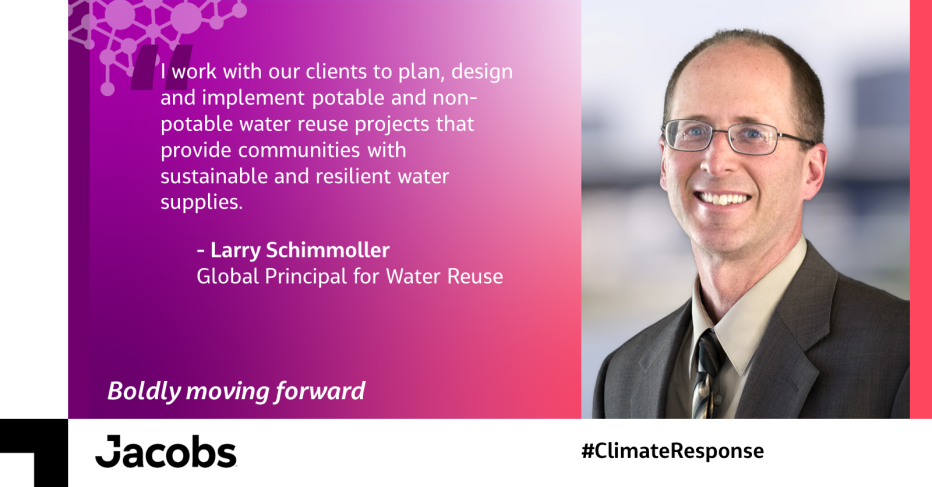A View on the Future of Water Reuse: A Q&A with Larry Schimmoller
Our Global Principal for Water Reuse has spent more than 25 years supporting Jacobs’ clients on water reuse projects. In this Q&A, Larry shares his perspectives and advice as more communities look to adopt water reuse as a drinking water supply solution
As water scarcity challenges intensify under climate change, the need for reliable, drought-resilient water supplies is increasing worldwide. In response, more communities are choosing to adopt water reuse practices and embrace the OneWater principle that all water has value. Advanced treatment technologies allow water utilities to cost-effectively reclaim and repurpose wastewater as a high-quality, resilient water supply – and increasingly for drinking water purposes.
Jacobs has been at the forefront of water reuse for decades, beginning in the 1960s with the first ever application of advanced wastewater treatment techniques in the western U.S. We received the Stockholm Industry Prize for advancing potable reuse and public acceptance in 2015 – a recognition to our contributions to the field. . The key to our longstanding leadership? Our talented global team of water professionals that support our clients every day with innovative water reuse solutions.
In this Q&A, we connect with one of these teammates, Jacobs Global Principal for Water Reuse Larry Schimmoller, who has spent most of his 30+ year career at Jacobs advancing water reuse practices in the global water sector. Larry explains how the adoption of water reuse is changing and provides some advice for communities interested in adopting the practice.

Hi Larry, can you tell us how the work you do is helping deliver Jacobs’ strategy?
I work with our clients to plan, design and implement potable and non-potable water reuse projects that provide communities with sustainable and resilient water supplies. These projects are becoming increasingly important across the world as we adapt to the impacts of climate change – and they’re a key example of our commitment to support clients with climate response.
You’ve been focused specifically on water reuse for the past 25 years. In what ways has the perception and adoption of water reuse changed during your career?
Although non-potable reuse remains important and useful in many locations, there’s been a general shift in the water industry to consider water reuse more actively for drinking water purposes. That’s because potable reuse can be used year-round, whereas non-potable reuse is often reduced or shut-off during the winter season, thus stranding these assets for portions of the year.
The focus on implementing potable reuse has also been supported by increased public acceptance, largely due to significant outreach efforts by utilities, and by the development of potable reuse regulations in a number of U.S. states. California is one state leading the way on potable reuse regulations and there are many major programs under way there. For example we were recently selected by LA Sanitation and Environment (LASAN) and the Los Angeles Department of Water and Power (LADWP) to design and build the Donald C. Tillman Advanced Water Purification Facility – one of the largest potable reuse projects currently being implemented in the U.S.
At the same time, numerous advancements in technology are occurring to support wider adoption of water reuse, including enhanced on-line water quality monitoring analyzers, alternative treatment approaches that can be used when disposal of RO concentrate is difficult (e.g., inland locations), and high-recovery reverse osmosis treatment approaches to maximize the amount of water that is reused.
As communities respond to the impacts of climate change, how important will water reuse be as a solution?
With the anticipated reduction in precipitation in some geographies due to climate change, water reuse is, and will continue to be, an important water supply option that should be considered in a utility’s water supply portfolio. For some, water reuse will likely be a top choice for an alternative water supply. For others, economic and non-monetary factors may suggest its implementation is not as viable. The application of water reuse is very site specific with numerous factors to be considered – and that’s one area where we’ve been helping clients as they navigate those decisions.
In what other ways are we helping clients with their water reuse programs?
Over the decades we’ve supported an extensive list of clients and water reuse projects across the globe – from Singapore and Australia to the U.S. Our experience includes all types of water reuse and markets: municipal, industrial, power, non-potable reuse, potable reuse, groundwater recharge and surface water augmentation. We also help our clients across the entire project lifecycle – from planning and design through to construction and operations. For example, we’re providing comprehensive program management services for Pure Water Project Las Virgenes-Triunfo, while serving as the progressive design-build contractor for the Donald C. Tillman Advanced Water Purification Facility I mentioned earlier.
“Consider all types of reuse in your master planning efforts, including non-potable reuse, indirect potable reuse, and even direct potable reuse, because the technology and the engineering is now available to support all types.”
Is there a water reuse project or achievement that you’re personally most proud of?
One that I would highlight is Hampton Roads Sanitation District’s (HRSD) Sustainable Water Initiative for Tomorrow (SWIFT). It’s an iconic potable reuse project in southeast Virginia that will replenish a diminishing groundwater aquifer while simultaneously reducing harmful nutrient discharges to the sensitive Chesapeake Bay. I’m especially proud of helping HRSD over the past seven years develop a vision for SWIFT and collaboratively working with them to address numerous technical challenges necessary for successful deployment of the overall program.
What advice would you provide to communities that are considering implementing water reuse?
Consider all types of reuse in your master planning efforts, including non-potable reuse, indirect potable reuse, and even direct potable reuse, because the technology and the engineering is now available to support all types. Be proactive and transparent in communicating your plans with the public and engage local community leaders and experts to support your project, which will add credibility to your plans.
What excites you about the future of water reuse?
Many things about the future of water reuse excite me, but two main areas are the most exciting: 1) the increasing realization by many that water reuse provides a local water supply that is not impacted by drought or other water supply interruptions and 2) the focus by numerous U.S. states to promulgate potable reuse regulations. Both of these factors will lead to the implementation of more water reuse projects.
What do you enjoy most about being part of #OurJacobs?
The great people that I get to work with every day and the exciting and iconic projects we work on that make a difference to our communities and the environment.
About the interviewee

Larry Schimmoller is Jacobs’ Global Principal for Water Reuse. He has extensive experience with the design, construction, and operation of potable and non-potable reuse projects throughout the world and has served as the Principal Investigator (PI) or co-PI on numerous research projects focused on water reuse.
You might be interested in...
Join #OurJacobs team
What drives you drives us as we work to build a better world – together. At Jacobs, every day is an opportunity to make the world better, more connected, more sustainable. We’re always looking for dynamic and engaged people to join our team. Bring your passion, your ingenuity and your vision.
Future Foundations.
Co-creating the world to come

From developing climate resilience and transitioning to a low-carbon future, to modernizing and transforming infrastructure, governments and businesses face critical challenges. How they respond will define our future.
As our clients navigate these challenges, we help them think differently – working together to pioneer tomorrow's infrastructure solutions and build the foundations for a prosperous, secure future.













































